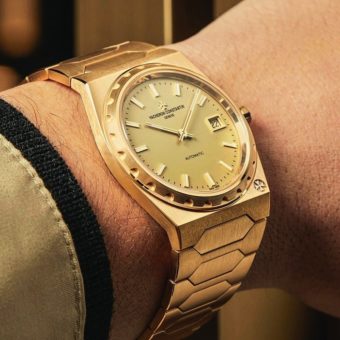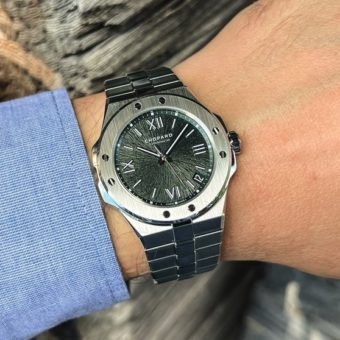Thomas Fleming recently launched his new brand, on which my esteemed collegue Bilal Khan wrote an excellent hands-on article, which you can find here. For me, it was also an opportunity to dig deeper in the background story behind these watches, talking with Thomas about what motivated him, and what he would like to achieve in the world of watches. The interview has been edited for clarity.

Martin Green: Where does your passion for fine watchmaking come from?
Thomas Fleming: I never thought anything of watches until a longtime friend turned 18, got a Tag Heuer Aquaracer as a gift from his parents, and shared the concept of a mechanical watch with me for the first time. I’ve always been a bit of a geek for mechanical things, and when he explained how the watch had no battery and instead just needed to be wound every so often, that his dad got one when he was 18 that he still wore daily thirty plus years later, and that it could endure diving hundreds of feet below the surface— I started down a rabbit hole from which it appears I’ll never emerge!
I initially was most interested in purpose-built tool watches; I thought (and still do) that the stories that went into creating them, as well as those their creation enabled, were incredibly intriguing. Over time, though, I became increasingly obsessed with fine watchmaking; the fact that it continues to endure and advance despite there being no practical reason for it to is really amazing to me. It’s all about emotion, entirely freed up from practical considerations, which allows for creativity and artistic expression to take over, constrained only by the limits of human ability (which is continually advancing, especially when combined with cutting-edge micro-machining).
MG: There is no shortage of independent brands these days. Why start another one?
TF: I approach watches in the way I think many approach art in a more general sense, and that holds true with how I think about this question; each individual will have ideas for explorations that are unique to them, and it’s always valid to be interested in realizing them. That being said, I personally wouldn’t start a brand unless I felt my ideas were something that I could also build a company around and would find a place in the market, and I also wouldn’t compromise what interested me personally in order to try and cater to the market; the two needed to be aligned, and in this case, I felt they were.
Our first watch, the Series 1 Launch Edition, is really about interpreting and realizing perhaps the most classic concept in watchmaking — the time-only watch — in our own, new way. The other concepts we will explore in the near future and have been developing over the past few years are very unique in and of themselves, but I thought it would be best to introduce our brand by approaching something very traditional conceptually, but executing it in a very different way.
I’ve always been a huge fan of simple watches executed really well (and there’s lots of subjectivity, which is great as well; something I love might be hated by someone else, and both views are valid), and on a selfish level, I just really wanted to try my hand at making a watch in this category. That being said, I also think it serves as a good way to usher in our brand, as I believe providing a familiar platform allows the approaches we’ve taken to developing our design language and to bringing the watch to life to stand out and be understood more easily than if the base concept itself was totally new, as well.
After designing a number of watches now, I also found this model’s design to be the most difficult. Every other brand/watchmaker has released their own interpretation of this watch, meaning it’s very hard to stand out — and stand out in a good way, as designing just to be different isn’t an approach that I care for or feel produces good results. A requirement for simplicity also means that there are really only details to play with, and any detail that isn’t executed well or coherent with all others stands out sorely; there’s nowhere to hide and no complications to, for better or for worse, distract the wearer. As such, it forced us to try to clear a really high bar from the beginning, and while that’s very difficult, I felt we’d be set up well for the future if we managed to clear it. The whole process was often frustrating and certainly not quick, and though the result certainly won’t resonate with everyone — which is perfectly OK, and the fact that nothing does is something I love about watchmaking — I personally know I’ve done everything in my power to design the best version of this watch I could, and I’ve been extremely fortunate to have found incredible partners to work with to realize it in the metal.

MG: What were the requirements for the movement, and how did the development process go?
TF: When I started looking for a movement,, I wanted to use something that wouldn’t compromise the desired proportions of the watch, could be made interesting visually (and in a unique way), was worthy of being finished to a high standard, and that I was confident would be reliable. I considered lots of different movements, and also considered starting from scratch, before settling on working with Chronode to create our own version of their 7-day caliber.
The Chronode caliber ended up being the perfect starting point for this project; it’s very thin (under 4mm thick), allowed for lots of customization in terms of design and even some in terms of function (we added a movement-side power reserve indicator, which, along with the very long power reserve, is a fun technical twist that aligns with the way we approached this watch conceptually and also doesn’t compromise the purity of the dial design), and has a proven track record as far as reliability goes.
I don’t think we could’ve designed a movement from scratch that’s as impressive from a technical perspective or fit our needs better, and reliability would’ve been a question mark for the first few years. We would’ve essentially just been doing it for the sake of doing it and likely compromising in a number of areas vs. the movement we’ve created with Chronode, which makes absolutely no sense when our goal was just to create the best version of this watch we could. We couldn’t be happier with how our the first movement from our collaboration with Chronode and Jean-François has turned out, and we have a lot more planned together over the next few years!

MG: You work together with some of the best suppliers in the business. Is this part of the strategy of the brand, or do you also aim at having (some) in-house production?
TF: Put very simply — and perhaps a bit inelegantly — our goal is just to create the best version of each watch that we can with whatever resources are available to us. For a watch, such as the Series 1 Launch Edition, that requires lots and lots of different skills to be executed at a very high level, the way to do that is to partner with incredible independent artisans and suppliers — assuming they’re willing to work with us, and we’re very grateful and fortunate that they were. I — or anyone else — could not have possibly convinced all of them to work under one roof and only for one brand; there are so many different areas of expertise required, and beyond that, they rightfully value their independence in getting to pick and choose which projects to work on, and also enjoy working on different things.
I don’t personally care one bit about the in-house label as it pertains to us, but if there is something at some point that we think could be done better in some way if we did it ourselves, then we’re very open to that. We will move to create our own prototyping lab in the coming year, as prototyping is more about speed of iteration than quality, and we’ve found it difficult to work with suppliers to create developmental prototypes very quickly.
MG: What made you opt to offer the watch in Tantalum in addition to traditional precious metals?
TF: I personally just love the hue of polished tantalum, and it’s something that you cannot replicate with any other material. It’s massively difficult to work with both in terms of machining and polishing, and Efteor deserves eternal credit and thanks for putting so much time into figuring out how to realize our cases in tantalum without making any compromises in terms of finishing or design. It wasn’t something I was sure would be possible, and other suppliers we approached didn’t think it would be, but Efteor made it happen after about 2 years of work.

MG: What are the difficulties working with this material compared to platinum and gold?
TF: It’s very gummy when it’s being machined, is hard on tooling, and also can even be flammable if not well-lubricated during the process, all meaning that making the same case in tantalum vs. gold or platinum involves much more than just swapping out the material. Once the raw case is machined, though, the difficulties are only beginning, as polishing it is a nightmare as well. It’s really difficult to achieve a polish without “orange peel” imperfections, and while lapping machines can be quite helpful on uniform surfaces, organic surfaces must be dealt with by hand. This case design and tantalum are a match made in hell for a case-maker; the lugs in particular are complex in construction, faceted, and must be machined separately from the mid-case, causing trouble when it comes to machining, polishing, and finding a way to attach them (tantalum’s really high melting point meant fusing via heat didn’t work well, so we had to reengineer the construction of the case and attach via screws instead — which brought its own set of challenges).
MG: What do you hope to achieve with your brand in the next few years?
TF: I’m not a huge fan of talking in hypotheticals about what might happen, and I also don’t want to give too much away regarding our future plans and products. That being said, I will say that we have been working hard on developing and realizing a number of other concepts — most of them quite unlike anything on offer in the market currently, and even each other — and we’re really looking forward to unveiling those in the coming years.
Being a brand new independent brand certainly isn’t easy or advantageous in every respect, but it is incredibly fun and freeing to be able to chart our own path, explore concepts that interest us, and operate in the way and on the timeline we think is best; while we don’t have history as a crutch to lean on, it also means we’re totally unconstrained by conceptions of what we represent or “should” be making. Our complete independence also means we can plan and operate in the way we think sets us up best for the long term instead of having to worry about short-term pressures or infighting amongst stakeholders, and over the coming years, I think the advantages of that approach will be increasingly apparent when one looks at our brand, our watches, and our stories.

I’ve said a number of times that we are very focused on creating the best version of each of our watches that we can, but I also want to go back to something I touched on in response to your first question on what first interested me in watchmaking: the stories. Watches in this day and age are about emotion, and it’s important to me to build an ecosystem around them and create stories with them, — not just on the creationary side, but also afterwards. Our collaboration with Casper Ruud is a good first example: we were brought together by a mutual love for watches, tennis (and golf — we both are obsessed), and an enthusiasm creating new kinds of lightweight, shock-resistant watches together, and the collaboration is long-term and genuine; he’s not a human billboard of sorts, as is sometimes the case with celebrity “partners”.
The first watch we’ve developed together is nearly ready, and I think people will be very surprised about the direction we’ve taken — hopefully in a positive way! There is a really unique story behind the creation of the watch — in terms of Casper’s involvement and how it came to be, the engineering required to make it possible, the incredible watchmakers and artisans bringing it to life, and so on — and we also will have created something that will be Casper’s companion in every match he plays. To me, that is very meaningful, and I know it will be to plenty of others, as well. Some won’t care in the least, which is of course also totally valid, but the watch will still be better for being developed the way it has been and will allow the owners who perhaps aren’t intrigued by the existing stories to create their own with their personal watches.
In short, it’s important to us to build a brand over the coming years that really considers the whole of what watches represent; the watches themselves are the most important piece of the puzzle, but it’s also essential in our view to build an ecosystem around them. It’s been very fun developing our first watches over the past few years, but the story doesn’t end there, and I’m equally excited to get them onto the wrists of those with whom they resonate and out into the world.
For more info, visit Fleming, here.






